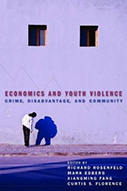Economics and Youth Violence: Crime, Disadvantage, and Community

Editors: Richard Rosenfeld, Mark Edberg, Xiangming Fang, and Curtis S. Florence
Publisher: New York: New York University Press, 2013. 334p.
Reviewer: Matt DeLisi | May 2014
The idea that economic factors are associated with crime permeates conventional wisdom and has been a part of criminological theory for nearly a century. In Economics and Youth Violence: Crime, Disadvantage, and Community, Richard Rosenfeld, Mark Edberg, Xiangming Fang, and Curtis S. Florence (hereafter referred to as the editors) advance an edited volume that contains 11 chapters that aim to specify the economics-crime link from multiple perspectives.
In their introduction, the editors articulate a multilevel explanatory framework that encompasses five domains (society, community, situational, individual, and youth violence) and two temporal dimensions (short-run factors and impacts and long-term factors and impacts). In the short-run, cyclical economic change, reduced social spending, and changes in economic inequality are theorized as societal factors that influence youth violence. These societal changes affect five community conditions: job loss from local business closings, public budget cutbacks, cyclical unemployment, reduction in after-school activities, and increased incidence of violent behavior as a characteristic of the community environment. At the situational level, these factors increase drug market volatility, increase the market for stolen goods, influence fluctuations in access to firearms, and increase youth gang membership and prevalence. At the individual level, seven short-run factors are specified. These are: increased likelihood of low-wage, unstable employment, economically induced stressors, increases in dysfunctional coping (e.g., drug and alcohol abuse), increased truancy, increased dropout, and decreased school participation, negative attitudes toward school, changes in calculations of risk, and increased firearm carrying. In terms of youth violence, the short-term effects of economic conditions are increased violence and firearm use.
In the long-term, societal changes result in job loss from outsourcing, unbalanced levels of global unemployment and poverty, deindustrialization, economic inequality, and media marketing of violence. At the community level, these produce chronic joblessness for youth and families, concentrated poverty, poor housing characterized by exposure to environmental toxins, physical degradation of neighborhoods, lack of access to health care, secondary labor markets, family disruption and instability, outmigration of better-off residents, low collective efficacy, low community attachment, and immigrant enclaves. At the situational level, these result in lack of plausible job paths, few prosocial adult role models, ineffective parenting, history of family problem behaviors, high levels of family violence, abuse, and neglect, limited adult supervision, disorganized school climate, limited social capital outside of street environment, a violent street code, and easy access to firearms. At the individual level, the long-term factors are chronic unemployment for youth and families, educational deficits, low expectations with respect to mainstream economic and social roles, high expectations with respect to gains from street economy, low perceptions of personal safety, decreased reliance on family for support, and cognitive-behavioral deficits resulting from violent victimization and various environmental pathogens. Taken together, the long-term factors produce chronically high levels of community violence, chronically high levels of family violence, abuse, and neglect, and the persistence of violent street codes. Against this ambitious conceptual model, the volume contains chapters on the effects of the business cycle on crime and violence (Chapter 2 by Bushway, Cook, and Phillips), linkages between economic downturns and crime (Chapter 3 by Baumer, Rosenfeld, and Wolff), economic conditions and violent victimization (Chapter 4 by Lauritsen, Gorislavsky, and Heimer), the nonlinear effects of neighborhood disadvantage on youth violence (Chapter 5 by Fang, Rosenfeld, Dahlberg, and Florence), aggravated inequality and the nexus of economics, schools, and delinquency (Chapter 6 by Crutchfield and Wadsworth), street markets and violence (Chapter 7 by Edberg and Bourgois), incarceration and economic effects on neighborhoods (Chapter 8 by Fagan and West), economic influences on child development (Chapter 9 by Guerra), macroeconomics of youth violence (Chapter 10 by Matjasko, Barnett, and Mercy), and an overview/summary look to the future (Chapter 11 by Florence and Barnett).
The chapters are mostly empirical and contain fairly sophisticated models using large-scale sources of data. The findings in the chapters are interesting and at times difficult to predict. Some crimes appear to closely respond to economic conditions whereas others crimes do not. Taken as a whole, the chapters reveal that the relationships between economic factors and antisocial behavior are complex and occur at multiple levels—just as the editors indicated in their conceptual model described earlier. It is pleasing to see economic-crime research that is so nuanced and aware of the influences of structural factors on situational dynamics and individual propensities. In this way, the volume is much more palatable than classic Marxian and Mertonian theorizing about crime that was too crudely structural.
The volume reveals both the greatest failure and the greatest insight about the role of economic factors on the etiology of antisocial behavior. Many times, economic adversity does not produce crime, but produces conventional social behavior. For instance, reduced job opportunities serve as an impetus for greater educational attainment. College enrollments grow during tough times. Economic down times can also contribute to greater savings among individuals and companies, and thus contribute to reduced debt. Crime declined during The Great Recession of late 2007 to 2009, and crime has ticked up during the recovery from this recession. A potential reason is that many of the economic “causes” that are discussed in the text could easily be viewed as correlates or even outcomes of other factors, such as criminal propensity and subcultural factors. For evidence, there is a negative association between immigrants and crime even though new immigrants have the lowest socioeconomic status. In Anderson’s influential street code (which is cited in most of the chapters in this volume), decent people did not commit crime whereas street people did—even though they often shared the same economic circumstances. In other words, unless one is deeply committed to a structural approach to crime, many of the putative relationships between economic disadvantage and crime lack basic face validity.
But the greatest success of the volume is the multidimensional ways that poverty can seep into all social institutions and all aspects of human development. My favorite chapter in the volume is Guerra’s conceptual chapter which reviews the effects of poverty on child development. Poverty has important biosocial consequences for human behavior, and Chapter 9 really centers on that. In this way, Economics and Youth Violence: Crime, Disadvantage, and Community by Richard Rosenfeld, Mark Edberg, Xiangming Fang, and Curtis S. Florence is worth reading for a multifaceted look at the economics-crime relationship.
Matt DeLisi, Professor and Coordinator of Criminal Justice Studies, Iowa State University


